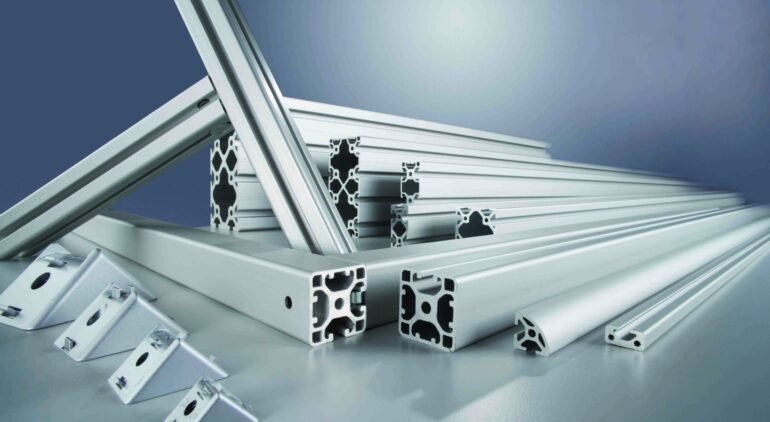Exploring the World of Aluminium Extrusion
Aluminium extrusion profiles are versatile building materials used across many industries. Their lightweight yet durable properties make them suitable for a wide range of applications. This article will explore what aluminium extrusion profiles are, along with how they are made, as well as common ways they are utilized. You will break this down into five key sections: material properties, manufacturing process, construction uses, industrial applications, and future innovations. By the end, you will have a better understanding of these versatile materials and how they are transforming various sectors.
- Material Properties
Aluminium extrusion profiles derive their versatile material properties from the aluminium alloy used in their construction. Aluminium is intrinsically a lightweight metal, yet it possesses good durability along with strength even without additional elements added. It can withstand corrosion from weathering as well as harsh environments quite well on its own due to a protective oxide layer that forms on the surface. Another advantage of aluminium is that it is non-toxic, so extrusion profiles can be used in applications involving food or consumer products without risk of contamination. To enhance aluminium’s inherent characteristics, other metals like magnesium, silicon, copper or zinc are mixed in during alloying.
This alloying process improves the metal’s performance in key ways. Magnesium, as well as silicon, increases the strength of the aluminium, allowing it to support heavy loads without failure. Copper enhances corrosion resistance, fortifying the protective oxide layer. Zinc improves the alloy’s machinability, making it easier to cut, drill, along with bend as well as otherwise form the raw material during manufacturing. The end result is an aluminium alloy for extrusion profiles that excels in strength for its lightweight composition. Profiles maintain high loads yet are not bulky to transport or install. Their corrosion resistance endures harsh conditions without deterioration. Best of all, the alloy’s machinability allows intricate shapes to be readily fabricated.
- Manufacturing Process
The key process that turns aluminium alloy into finished extrusion profiles is extrusion. It begins by heating cylindrical blocks of aluminium alloy to their semi-molten state. Heating the alloy makes it soft and malleable enough to be forced through the extrusion press. The heated alloy is then loaded into the chamber of a powerful hydraulic or mechanical press. At the bottom of the chamber sits a pre-formed metal die, which has an opening that determines the final cross-sectional shape of the extruded profile. Examples include tubes, bars, angles or custom designs. Under extremely high pressure, sometimes over 100,000 pounds per square inch, the press forces the semi-molten alloy through the die opening.
As it is squeezed through, the alloy takes on the exact shape of the die cavity. This creates a continuous, uniform profile of indefinite length as it is extruded. After exiting the die, the long extruded profile is pulled through a series of rolls and guides. It is then cut to desired lengths by a saw or shear. The cut profiles undergo post-extrusion processing like finishing, cleaning, anodizing, or powder coating. This protects the aluminium alloy from corrosion and also enhances its appearance. The extrusion process turns aluminium billets into finished, net-shape profiles in a single, continuous step. It allows for highly automated, high-volume production of profiles with tight dimensional tolerances. The end results are consistent structural shapes that can be used immediately for fabrication.
- Construction Uses
Aluminium extrusion profiles see widespread use in the construction industry due to their strength, durability and resistance to corrosion. Common applications include window and door frames, curtain walls, balcony railings, roofing structures, scaffolding and signage frames. Their lightweight properties are especially beneficial for large commercial buildings as it reduce structural loads. Extrusions are also used to create modular construction systems for temporary or permanent structures. Their corrosion resistance and recyclability make them a sustainable choice for buildings. Extrusion profiles can be combined with other materials like glass, wood or composite panels to create high-performance building envelopes. Their customizability allows architects and engineers to realize unique structural designs.
- Industrial Applications
Beyond construction, aluminium extrusion profiles find many applications across various industrial sectors. They are commonly used in transportation manufacturing due to their strength and lightweight. For example, extrusions form structural components in aircraft, ships, trucks, trains and more. The automotive industry utilizes extrusions for chassis components, suspension parts and other load-bearing applications. Extrusion profiles are also well-suited for machinery and equipment manufacturing due to their machinability and durability. They create frames, housings and protective guards. Other industrial uses include tooling applications, renewable energy structures, agricultural equipment, ladders, scaffolding and more. Their corrosion resistance makes extrusions suitable for harsh, wet industrial environments as well.
- Future Innovations
Looking ahead, aluminium extrusion profiles continue to be developed with new alloys, finishes and production techniques. Advances in 3D printing and additive manufacturing open possibilities to create even more complex extrusions with minimal waste. New aluminium alloys containing scandium or lithium offer improved strength and corrosion resistance. Sustainable production methods aim to reduce energy usage and increase recycling rates. Extrusion profiles integrated with other materials through co-extrusion or hybrid fabrication unlock novel designs and performance benefits. As sustainability and light weighting become greater priorities, aluminium extrusions are poised to transform more industries through innovative applications. From construction to transportation to renewable energy, these versatile structural materials will remain important building blocks for the future.
Conclusion The standard aluminium extrusion profiles are lightweight yet durable structural materials made through a continuous extrusion process. Their corrosion resistance, high strength-to-weight ratio and customizability make them suitable for a wide variety of applications. Extrusions see extensive use in construction for building envelopes, as well as across industrial sectors like transportation, machinery, equipment and more. Through ongoing material innovations and production advances, aluminium extrusions will continue to transform built environments and products. Their sustainable properties cement aluminium extrusions as an important building material for the future. With applications limited only by imagination, these versatile profiles remain a mainstay across many industries.




